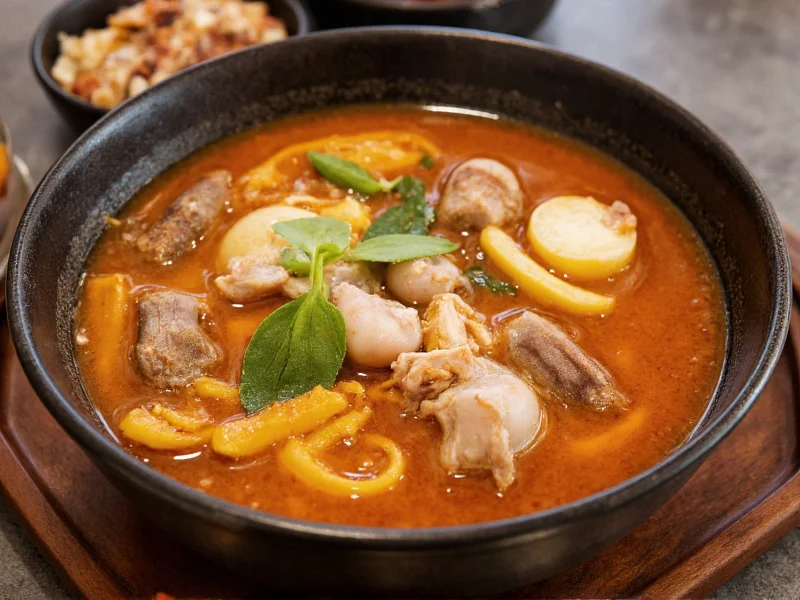Understanding the nuances of this beloved Thai comfort food reveals why it stands apart in Southeast Asian cuisine. While many Western diners confuse tom ka kai with its cousin tom yum, the coconut milk base creates a fundamentally different culinary experience that showcases Thailand's sophisticated approach to balancing complex flavors.
Decoding Tom Ka Kai: More Than Just Thai Chicken Soup
The name "tom ka kai" provides immediate clues to its composition. "Tom" refers to the boiling cooking method common in Thai soups. "Ka" specifically denotes coconut (not to be confused with "kha," which means galangal). "Kai" means chicken. This precise naming convention reflects Thai culinary tradition where dish names often describe preparation method and key ingredients.
What truly distinguishes authentic tom ka kai from Western interpretations is its flavor architecture. Traditional versions maintain equilibrium among four essential elements:
| Flavor Element | Primary Source | Traditional Proportion |
|---|---|---|
| Spicy | Fresh bird's eye chilies | Moderate (adjustable) |
| Sour | Fresh lime juice (added at end) | Pronounced but balanced |
| Sweet | Natural coconut sweetness | Subtle background note |
| Salty | Fish sauce (nam pla) | Enhances other flavors |
Essential Ingredients for Authentic Flavor
The holy trinity of Thai soup aromatics forms the foundation of tom ka kai's distinctive taste. Unlike Western broths that might use ginger, authentic preparation requires:
- Galangal (kha) - Often mistaken for ginger but has sharper, pine-like notes. Never substitute ginger as it creates entirely different flavor profile
- Lemongrass (takhrai) - Only the tender lower third should be used, finely sliced against the grain
- Kaffir lime leaves (bai makrut) - Must be torn, not cut, to release essential oils
Coconut milk quality proves equally critical. Traditional recipes use freshly squeezed coconut milk rather than canned varieties. The first pressing provides rich creaminess while subsequent pressings create lighter broth. When using canned coconut milk, shake well before opening and avoid 'lite' versions which contain stabilizers that affect texture.
Mastering the Cooking Technique
Many home cooks struggle with coconut milk separation, the most common tom ka kai failure. Professional Thai chefs follow precise temperature control:
- Simmer aromatics in water first to extract flavors without risking coconut curdling
- Add protein (traditionally free-range chicken) and cook until nearly done
- Reduce heat to just below simmering point before adding coconut milk
- Never allow coconut milk to reach full boil after addition
- Add lime juice and fish sauce only at the very end to preserve bright acidity
The sequence matters as much as ingredients. Adding lime juice too early causes bitterness, while premature fish sauce addition can make the soup overly salty as liquid reduces. Authentic tom ka kai should have a pale yellow hue from the coconut milk, not the red-orange of many Westernized versions that overload on chili paste.
Regional Variations Across Thailand
While Bangkok restaurants often present a standardized version, regional differences reveal tom ka kai's versatility:
- Central Thailand - Balanced flavor profile with moderate spice, often includes straw mushrooms
- Northern Thailand - Milder version using local herbs, sometimes with addition of pickled mustard greens
- Southern Thailand - Noticeably spicier with greater chili content, sometimes incorporating local seafood
- Isaan (Northeast) - Incorporates fermented fish sauce (pla ra) for distinctive umami depth
Street food vendors frequently offer tom ka kai as a quick lunch option, using pre-made broth bases but finishing with fresh ingredients. Home cooks might simplify by using store-bought broth but maintain authenticity through proper ingredient sequencing and balance.
Nutritional Benefits and Dietary Adaptations
Traditional tom ka kai provides notable health benefits from its medicinal herbs. Galangal contains anti-inflammatory compounds, while kaffir lime leaves offer antioxidant properties. The coconut milk provides medium-chain triglycerides that metabolize differently than other fats.
Dietary adaptations maintain authenticity while accommodating restrictions:
- Vegan version - Substitute chicken with tofu or mushrooms, use mushroom broth, and replace fish sauce with soy sauce-tamarind blend
- Gluten-free preparation - Naturally gluten-free when using pure fish sauce (check labels for wheat additives)
- Lower calorie option - Use light coconut milk but maintain first-press richness for flavor
A single serving (1 cup) of traditional tom ka kai contains approximately 180-220 calories, with 12-15g fat (primarily from coconut), 8-10g protein, and 6-8g carbohydrates. The soup's high water content and complex flavors create satiety with relatively modest caloric intake.
Common Preparation Mistakes to Avoid
Even experienced cooks make critical errors when preparing tom ka kai. The most frequent issues include:
- Using ginger instead of galangal - Creates completely different flavor profile
- Adding coconut milk to boiling liquid - Causes immediate separation
- Overcooking delicate ingredients - Lime juice and fish sauce lose complexity when boiled
- Imbalanced flavor progression - Adding sour elements too early creates bitterness
- Using canned coconut milk without shaking - Results in inconsistent texture and flavor
Professional chefs recommend tasting and adjusting at three critical points: after aromatics have infused the broth, after adding coconut milk, and in the final minute of cooking. This incremental approach ensures proper flavor development without overshooting any element.
Serving Traditions and Cultural Context
In Thailand, tom ka kai functions as both comfort food and medicinal remedy. Many Thais consume it when feeling under the weather due to the therapeutic properties of its ingredients. Unlike tom yum which often serves as a standalone dish, tom ka kai typically appears as part of a multi-dish meal.
Traditional serving customs include:
- Served hot but not piping hot to preserve delicate coconut flavors
- Accompanied by steamed jasmine rice (never sticky rice)
- Often paired with a simple stir-fried vegetable dish
- Rarely served as a first course; usually appears with main dishes
The soup's creamy texture makes it particularly popular during cooler months, though Thailand's tropical climate means it appears year-round. Many Bangkok office workers consider it ideal lunch fare that provides substantial nutrition without afternoon lethargy.











 浙公网安备
33010002000092号
浙公网安备
33010002000092号 浙B2-20120091-4
浙B2-20120091-4